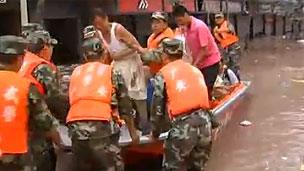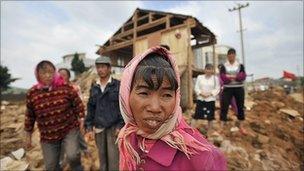Chinese villagers helpless in face of devastating floods
- Published
The BBC's Damian Grammaticas on the rescue effort in Guang'an City in Sichuan province
As we stood by the edge of the flooded streets in Guang'an's old town, a middle-aged woman suddenly rushed forward from the crowd.
Clasping a bucket and a bag she dived into the filthy brown waters, flailing her arms.
She was so desperate to get to her flooded home that she was trying to swim there. A couple of policemen leapt in after her and carried her back to safety.
In long lines stretching back from the edge of the flood more people stood and waited.
Some were carrying food to take to stranded relatives, others held brushes and brooms hoping to clean the debris from homes and shops as the water receded.
Every few minutes a rescue boat appeared, cruising down what was, two days ago, a busy street.
Now the water was lapping at the roof of the shops.

Soldiers rescue those stranded by the floodwaters from the river Qu
The boats would pull in, deposit another load of people who had been picked up from their cut-off homes, and then load up with those hoping to get in to the flooded area.
One woman in the queue said it was the worst flood she had ever seen.
"The health clinic where I work is on the ground floor of the building. It was completely underwater. Now I am waiting to see if I can go back. "
Mr Ye, whose family has a shop selling pianos and musical instruments, said they had lost almost everything.
"Our shop was totally submerged. We thought the flood would only affect the street level so we moved things up to the next floor. But that was submerged too.
"I estimate we have lost up to 60,000 yuan (£5,800)."
Impressive clean-up
The flood was caused by the river Qu, which flows down from the mountains and sweeps through Guang'an in a broad curve.
On Monday, after days of torrential rains here in Sichuan in south-western China, the Qu rose.
It breached its banks and poured down the streets of the old town. All day the water kept on rising.
Li Yong Ping, head of Guang'an's district administration, overseeing the rescue efforts told us no one had seen anything like the flood in living memory.
"This flood is the worst since 1847. Before it happened we managed to move people who were in danger.
"So now we are focusing on cleaning up the area and making sure no disease breaks out here," he said.
The rescue and clean-up were impressively organised. Teams of police in military fatigues manned a fleet of boats.
They handed a bright orange life-jacket to each person they took on board.
Groups of government office workers had been despatched to help sweep away the thick layer of silt that had covered the streets.
So men and women in their smart office clothes waded gingerly through the thick sludge wielding brushes.
A group of electrical repair men turned up to install waterproof street lights. All the while public loudspeakers played old, cultural revolution-era songs to keep up people's spirits.
Floodwater surge
It is not only Guang'an that has been affected. Torrential rains have been falling for weeks across a swathe of central and southern China and they have caused huge damage across almost a dozen provinces.

Floods have damaged or destroyed more than 100,000 homes in China
Downstream from Guang'an, the waters from the Qu river flow into the Yangtze, and then into China's massive Three Gorges dam.
On Monday night the dam experienced the biggest surge of water since it began operating four years ago.
The level in its reservoir rose 4m (13ft) in just a day, reaching a depth of 150m - just 20m below its maximum.
China's authorities were trying to limit the flow of water out of the dam to try to contain the flood surge and protect areas downstream.
But there too there have been days of heavy rain. Tributaries flowing into the Yangtze have been flowing at danger levels and embankments have been weakened by the rain so more flooding has happened.
In July alone at least 146 people have died, drowning in the floodwaters or buried by landslides.
More than 100,000 homes have been damaged or destroyed, and 13 million people been forced to seek temporary refuge.
Taming the Yangtze
In Guang'an nobody lost their lives, but plenty have lost all they had worked for.

The Three Gorges Dam was designed to try to tame the destructive power of the Yangtze
We waded through the mud and the rubbish floating on the waters to reach Mr and Mrs Lou's shop on Nan Xing street.
The couple, in their 50s were trying to sweep the muck deposited by the river out of their hardware store, but it was an almost hopeless task.
Everything was sodden and coated in a layer of sticky brown silt.
This flood season has been one of the deadliest in years for China.
The Three Gorges Dam was designed to try to tame the destructive power of the Yangtze.
The dam may have helped limit the surge of water but still the sluices have been open and huge volumes have flowed downstream.
So it hasn't been able to stop the floods from affecting millions, both above the dam as in Guang'an, and below it too, as the summer rains have poured down.
- Published20 July 2010
- Published17 July 2010
- Published14 July 2010